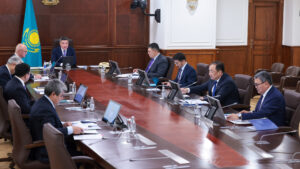Kentucky School District Setting the Pace in Energy Savings – Facilitiesnet

Report on Sustainable Development at Warren County Public Schools
Executive Summary
This report details the strategic initiatives undertaken by Warren County Public Schools (WCPS) in Kentucky, under the leadership of CFO/COO Christopher McIntyre, which align with the United Nations Sustainable Development Goals (SDGs). The district has successfully integrated sustainable practices into its financial and operational models, primarily through energy efficiency, resulting in significant cost savings that are reinvested to enhance educational quality and community well-being. WCPS serves as a model for leveraging sustainability to achieve core educational and economic objectives.
District Profile and Strategic Growth
Warren County Public Schools is a rapidly expanding district facing significant population growth. Its management strategies reflect a commitment to sustainable community development.
- Student Population: 18,750 (Fourth largest in Kentucky)
- Annual Growth: Approximately 450 students per year
- Projected Community Growth: Bowling Green is projected to expand by 90,000 residents over 25 years.
- Infrastructure: 32 campuses, including 15 elementary, four middle, four high, and five alternative schools, spread across 550 square miles.
This growth necessitates a forward-thinking approach to infrastructure, directly supporting SDG 11 (Sustainable Cities and Communities) by ensuring educational facilities can sustainably accommodate a growing population.
Integration of Sustainable Development Goals in Operations
SDG 7: Affordable and Clean Energy & SDG 13: Climate Action
WCPS has established itself as a leader in energy efficiency, making it a cornerstone of its financial strategy. This commitment to green initiatives directly addresses SDG 7 and contributes to SDG 13 by reducing the district’s carbon footprint.
- Financial Impact: The district achieves upwards of $5 million in annual energy savings.
- Pioneering Initiatives:
- Embraced geothermal energy over 40 years ago.
- Opened the first zero-energy school in the United States in 2009.
- Hired the first school district energy manager in Kentucky.
- Utilizes innovative construction technologies like insulated concrete form walls to reduce long-term energy costs.
SDG 4: Quality Education & SDG 8: Decent Work and Economic Growth
The district has created a virtuous cycle where energy savings directly fund human capital development, enhancing both educational quality and local economic conditions.
- Reinvestment Strategy: The $5 million in annual energy savings is reinvested directly into compensation packages for district employees.
- Impact on Education (SDG 4): This financial strategy strengthens the district’s ability to recruit, retain, and attract top educational talent, which is critical for providing quality education to its students.
- Impact on Employment (SDG 8): By offering competitive compensation, the district promotes decent work and economic stability for its staff.
SDG 9: Industry, Innovation, and Infrastructure & SDG 11: Sustainable Cities and Communities
WCPS actively builds resilient, innovative, and sustainable infrastructure to serve its students and the wider community.
- Resilient Construction: The district is engaged in ongoing projects to build storm shelters in cooperation with the Federal Emergency Management Agency (FEMA), enhancing community safety and resilience.
- Sustainable Modernization: Projects include converting grass athletic fields to turf, reducing water consumption and maintenance costs.
- Innovative Leadership: The district’s history of building zero-energy facilities and adopting new construction methods demonstrates a commitment to innovation in public infrastructure.
SDG 17: Partnerships for the Goals
WCPS leverages strategic partnerships to maximize the impact of its sustainability initiatives.
- Public-Private Partnership: In 2017, the district entered a 20-year, $30 million energy savings performance contract with the engineering firm CMTA.
- Scope of Partnership: This guaranteed contract covers comprehensive energy upgrades at nearly 30 district buildings, ensuring long-term efficiency and savings.
- Knowledge Sharing: Mr. McIntyre actively shares the district’s success story at national forums and trade shows, fostering collaboration and encouraging other districts to adopt similar SDG-aligned strategies.
Governance and Stakeholder Engagement
Financial Accountability and Public Trust
The district’s ability to fund these ambitious projects relies on a transparent financial strategy and strong public support. Upgrades are funded through a local tax rate increase, or “nickels,” which the school board has progressively utilized based on the district’s sustained growth. This demonstrates responsible fiscal management tied to community development.
Communication and Transparency
To maintain support from the board and the public, leadership employs a proactive communication strategy, which is vital for the success of its sustainability agenda.
- Regularly hosts facility tours to showcase project progress and outcomes.
- Holds office hours every other weekend for board members and the public to foster open dialogue.
- Engages in relationship-building to understand stakeholder perspectives and ensure alignment on district goals.
SDGs Addressed in the Article
SDG 4: Quality Education
- The article is centered on the Warren County Public Schools district. It highlights the direct link between the quality of schools and the community’s prosperity, as stated by Christopher McIntyre: “I know the success of our community is contingent on the success of our schools.” The district is actively “opening new schools and expanding current ones” to accommodate a growing student population, which directly relates to providing quality education.
SDG 7: Affordable and Clean Energy
- This is a primary focus of the article. The district’s commitment to “green initiatives” is driven by significant financial benefits, achieving “upwards of $5 million annually in energy savings.” The article details the use of clean energy technologies like “geothermal energy” and the achievement of opening the “first zero-energy school in the country,” clearly connecting to this goal.
SDG 9: Industry, Innovation, and Infrastructure
- The article discusses the construction and upgrading of infrastructure, specifically the 32 school campuses. The district’s approach involves innovation through the use of “insulated concrete form walls” and building a “zero-energy school.” This represents a move towards sustainable and resilient infrastructure.
SDG 11: Sustainable Cities and Communities
- The issues are discussed within the context of the growing Warren County and the city of Bowling Green. The district is proactively managing its growth and making its facilities safer and more resilient by “building storm shelters in cooperation with the Federal Emergency Management Agency.” This contributes to creating a sustainable and safe community.
SDG 17: Partnerships for the Goals
- The success of the school district is explicitly attributed to several key partnerships. The article mentions a public-private partnership with “CMTA, a Louisville-based engineering and design company,” for a “$30 million energy savings performance contract.” It also notes a public-public partnership with the “Federal Emergency Management Agency” for building storm shelters.
Specific SDG Targets Identified
SDG 4: Quality Education
- Target 4.a: “Build and upgrade education facilities that are child, disability and gender sensitive and provide safe, non-violent, inclusive and effective learning environments for all.” The article supports this by mentioning the district is “regularly opening new schools and expanding current ones” and “building storm shelters” to ensure student safety.
SDG 7: Affordable and Clean Energy
- Target 7.2: “By 2030, increase substantially the share of renewable energy in the global energy mix.” The article states that the district “embraced geothermal energy more than 40 years ago,” which is a form of renewable energy.
- Target 7.3: “By 2030, double the global rate of improvement in energy efficiency.” The district’s entire strategy is built on this, exemplified by its “$5 million annually in energy savings,” its position at the “top of the state’s energy efficiency list,” and the creation of a “zero-energy school.”
SDG 9: Industry, Innovation, and Infrastructure
- Target 9.4: “By 2030, upgrade infrastructure and retrofit industries to make them sustainable, with increased resource-use efficiency and greater adoption of clean and green technologies…” The district’s actions, such as the “$30 million energy savings performance contract” to upgrade nearly 30 buildings with green technologies, directly align with this target.
SDG 11: Sustainable Cities and Communities
- Target 11.5: “By 2030, significantly reduce the number of deaths and the number of people affected…caused by disasters…with a focus on protecting the poor and people in vulnerable situations.” The project of “building storm shelters in cooperation with the Federal Emergency Management Agency” is a direct measure to increase resilience to disasters and protect the student population.
SDG 17: Partnerships for the Goals
- Target 17.17: “Encourage and promote effective public, public-private and civil society partnerships…” The article explicitly details a public-private partnership with the engineering firm CMTA and a public-public partnership with FEMA, showcasing the model of collaboration to achieve sustainability and safety goals.
Indicators for Measuring Progress
SDG 4: Quality Education
- Implied Indicator: Number of new and expanded educational facilities. The article states the district is “regularly opening new schools and expanding current ones.”
- Implied Indicator: Number of schools with safety upgrades. The article mentions the project of “building storm shelters.”
SDG 7: Affordable and Clean Energy
- Indicator: Financial savings from energy efficiency measures. The article quantifies this as “$5 million annually in energy savings.”
- Indicator: Share of renewable energy in the energy mix. The use of “geothermal energy” is a specific indicator mentioned.
- Indicator: Number of zero-energy buildings. The article cites the opening of the “first zero-energy school in the country.”
SDG 9: Industry, Innovation, and Infrastructure
- Indicator: Investment in sustainable infrastructure upgrades. The article mentions a “$30 million energy savings performance contract” covering nearly 30 buildings.
- Indicator: Adoption of innovative and sustainable building materials. The use of “insulated concrete form walls” is mentioned as an example.
SDG 11: Sustainable Cities and Communities
- Indicator: Number of disaster-resilient structures built. The article specifies the construction of “storm shelters.”
SDG 17: Partnerships for the Goals
- Indicator: Number and value of public-private partnerships for sustainable development. The article identifies a “20-year partnership with the district on a $30 million energy savings performance contract” with CMTA.
- Indicator: Number of public-public partnerships. The article mentions a cooperation agreement with the “Federal Emergency Management Agency (FEMA).”
Summary Table of SDGs, Targets, and Indicators
| SDGs | Targets | Indicators |
|---|---|---|
| SDG 4: Quality Education | 4.a: Build and upgrade education facilities to provide safe and effective learning environments. | Number of new/expanded schools; Number of storm shelters built. |
| SDG 7: Affordable and Clean Energy | 7.2: Increase the share of renewable energy. 7.3: Improve energy efficiency. |
Use of geothermal energy; $5 million in annual energy savings; Existence of a zero-energy school. |
| SDG 9: Industry, Innovation, and Infrastructure | 9.4: Upgrade infrastructure to make it sustainable and resource-efficient. | $30 million investment in energy upgrades; Use of insulated concrete form walls. |
| SDG 11: Sustainable Cities and Communities | 11.5: Reduce the impact of disasters by protecting people and reducing economic losses. | Construction of storm shelters in schools. |
| SDG 17: Partnerships for the Goals | 17.17: Encourage and promote effective public, public-private and civil society partnerships. | Partnership with FEMA; $30 million public-private partnership with CMTA. |
Source: facilitiesnet.com

What is Your Reaction?
 Like
0
Like
0
 Dislike
0
Dislike
0
 Love
0
Love
0
 Funny
0
Funny
0
 Angry
0
Angry
0
 Sad
0
Sad
0
 Wow
0
Wow
0



























;Resize=805#)


















































